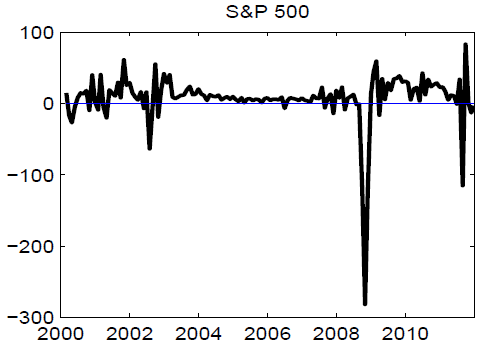Does the variance risk premium (derived from the mostly positive gap between options-implied equity market volatility and actual equity market volatility) robustly predict stock market returns worldwide? In the March 2012 version of their paper entitled “Stock Return Predictability and Variance Risk Premia: Statistical Inference and International Evidence”, Tim Bollerslev, James Marrone, Lai Xu and Hao Zhou test the statistical and geographic robustness of the power of the aggregate variance risk premium to predict overall stock market returns. Statistical robustness testing addresses sampling frequency and the use of overlapping measurement intervals. Geographic robustness testing involves measurement of the variance risk premium for French CAC 40, the German DAX 30, the Japanese Nikkei 225, the Swiss SMI and the UK FTSE 100. While tests in past research employ monthly data, they calculate the implied-realized volatility gap for the U.S. by subtracting a measure of the actual S&P 500 Index return variance over the past 20 trading days from the square of VIX (see the chart below). Using S&P 500 Index daily returns and VIX levels for February 1996 through December 2007 and comparable data for other country stock markets for January 2000 through December 2011, they find that:
- Variance risk premiums around the world are all positive on average, and a relatively high (low) risk premium indicates relatively high (low) future returns. In other words, “selling” volatility is profitable on average.
- Results suggest that high-frequency data (daily rather than monthly) increases the predictive power of the variance risk premium.
- The U.S. variance risk premiums relates positively to future stock market returns at horizons of two to four months, with peak predictive power around four months.
- Results for France, Germany, Japan, Switzerland and the UK exhibit a similar pattern of stock market predictability, maximized at a four-month horizon, but are generally weaker than that for the U.S.
- A global variance risk premium is a stronger predictor of future country stock market returns than country variance risk premiums, maximized at a horizon of four to five months.
- The global variance risk premium may be a proxy for worldwide economic uncertainty, aggregate risk aversion in world financial markets or a summary measure of disagreement in beliefs across international equity market participants.
The following chart, taken from the paper, plots the the monthly variance risk premium for the S&P 500 Index over the period January 2000 through December 2011, calculated by subtracting the actual index variance from the options-implied variance. Plots for France (CAC 40), Japan (Nikkei 225), Germany (DAX 30), Switzerland (SMI 20) and the UK (FTSE 100) have similar shapes.
Note that trading on the variance risk premium (for example, by selling implied volatility) is usually profitable but faces occasional disasters, with an extreme disaster in late 2008.

In summary, evidence from an array of tests indicates that the positive relationship between the aggregate equity variance risk premium (difference between implied and realized volatilities) and future stock market returns is fairly reliable and pervasive.
Cautions regarding findings include:
- In his November 2010 preliminary draft paper entitled “The Variance Risk Premium around the World”, Juan-Miguel Londono examines the variance risk premium in a different (but overlapping) set of eight countries during 2000 through 2009. He confirms that the premium is significantly variable and positive on average in all counties (with the average smallest for Belgium and highest for Japan). However, he finds that only the U.S. variance risk premium predicts future stock market returns (both for the U.S. and other country stock markets) for horizons of one to six months, peaking at about three months. Failure to find that variance risk premiums for other countries predict stock market returns may derive from differences in sample periods, sampling frequencies, approaches to modeling expected realized volatility and/or statistical test methods.
- The study does not devise or test ways to exploit the variance risk premium’s predictive power for future stock market returns.
- The “experimentation” employed in constructing some key relationships indicates the possibility of data snooping bias.